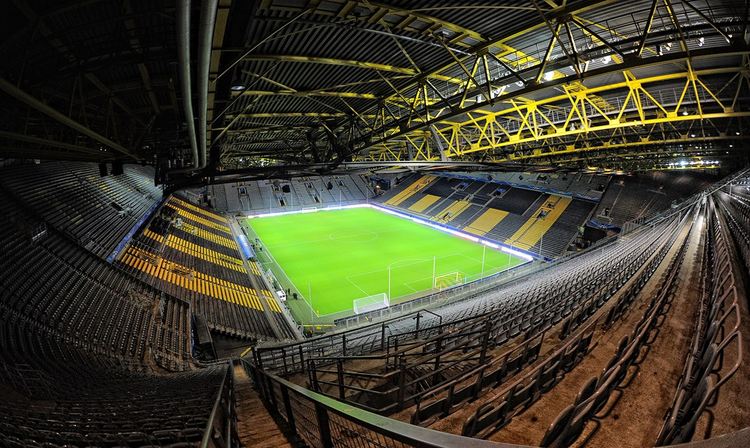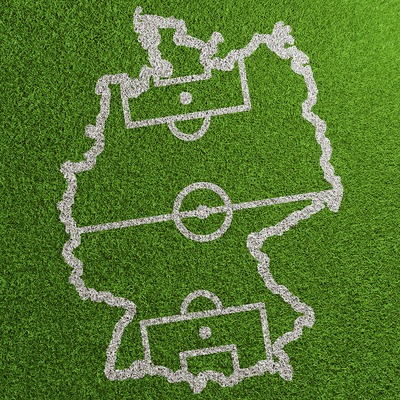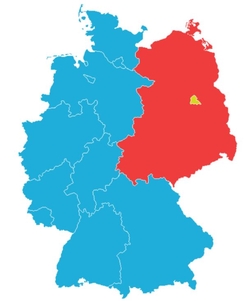Bundesliga Stadiums & Stats
![]() Known as the Bundesliga in England and often referred to as either Fußball-Bundesliga or 1. Bundesliga in Germany, this is the top-flight division of professional association football in Germany.
Known as the Bundesliga in England and often referred to as either Fußball-Bundesliga or 1. Bundesliga in Germany, this is the top-flight division of professional association football in Germany.
It runs alongside 2. Bundesliga as the German equivalent to English football’s Premier League and Championship.
Here we’ll take a look at the history of the Bundesliga as well as discuss the league’s set-up and the type of stadiums you can expect to visit if you pop over to Germany any time soon.
Es ist wunderbar!
Stadium Stats
| Stadium | Year Opened | Capacity | Ave Attendance | Record Attendance | Record Attendance Match |
|---|---|---|---|---|---|
|
Allianz Arena
Bayern Munich |
2005 | 75024 | 75000 | 75000 | B Munich v Schalke 04 (2015) |
|
BayArena
Bayer Leverkusen |
1958 | 30210 | 27769 | 30210 | Multiple Matches |
|
Borussia-Park
Borussia Mönchengladbach |
2004 | 54057 | 51715 | 54010 | |
|
Deutsche Bank Park
Eintracht Frankfurt e.V. |
1925 | 58000 | 56959 | 81000 | Eintracht Frankfurt v FK Pirmasens (1959) |
|
MHPArena (Stuttgart)
VfB Stuttgart |
1933 | 60058 | 55121 | 97553 | Germany-Switzerland (22nd November 1950) |
|
Red Bull Arena (Leipzig)
RB Leipzig |
2004 | 47069 | 45175 | 47069 | Several |
|
Rhein-Neckar-Arena
Hoffenheim |
2009 | 30150 | 28155 | 30150 | Hoffenheim v Cologne (2016) |
|
Signal Iduna Park
Borussia Dortmund |
1974 | 81365 | 81305 | 83000 | Dortmund v Schalke 2004 |
Team Stats
| Team | Year Founded | Nickname | Team Owner |
|---|---|---|---|
| Bayer Leverkusen | 1904 | Werkself | Bayer AG |
| Bayern Munich | 1900 | Der FCB (The FCB), Die Bayern (The Bavarians), Stern des Südens (Star of the South), Die Roten (The Reds), FC Hollywood | FC Bayern München AG |
| Borussia Dortmund | 1909 | Die Borussen, Die Schwarzgelben, Der BVB | Puma SE |
| Borussia Mönchengladbach | 1900 | Die Fohlen, Die Borussen | Fan Owned |
| Eintracht Frankfurt | 1899 | SGE (Sportgemeinde Eintracht), Die Adler (The Eagles), Launische Diva (Moody Diva, Schlappekicker (Slipper Kickers), Die Diva vom Main (The Diva From the Main) | 50+1 |
| Hoffenheim | 1899 | Die Kraichgauer, achtzehn99 | Dietmar Hopp |
| RB Leipzig | 2009 | Die Bullen (The Bulls), Die Roten Bullen (The Red Bulls) | Dietrich Mateschitz |
| VfB Stuttgart | 1893 | Die Roten (The Reds), Die Schwaben (The Swabians) | Claus Vogt |
Bundesliga Stadiums

Considering the Bundesliga has the highest average match attendance of any league in the world, it’s fair to assume that the grounds are bigger than grounds elsewhere in Europe. For example, Signal Iduna Park, otherwise known as the Westfalenstadion, has a capacity of over 80,000, whilst Bayern Munich’s Allianz Arena isn’t too far behind. There is an interesting mix of stadium types in Germany, with both older looking and brand new grounds commonly found across the Bundesliga.
Even middling teams in the Bundesliga boast grounds that are larger in capacity than their English equivalents. That said, just because they have a large capacity doesn’t mean that all of the grounds in Germany are necessarily huge and intimidating places to go. Rather, the fact that German football allows safe standing means that German stadiums can fit more supporters into them without needing to hugely expand.
Despite the fact that the Bundesliga has stadiums that were built as early on as the 1920s, the league is not full of decrepit old grounds that are likely to be closed down any day now. Instead they have some of the most modern and interesting looking grounds anywhere in football, with the majority of them built in the ‘Bowl Style’ that is now common with newer stadia. This allows for numerous levels of continuous seating instead of the more old-fashioned ‘English Style’ stadiums where each stand is a separate entity that runs along each edge of the football pitch.
About The League
 The Bundesliga is the highest attended football league on average anywhere in the world. Unlike with most other leagues across Europe, though, Germany’s top division has eighteen teams competing in it rather than the more common twenty. That means that each team plays 36 games in total over the course of a season, with one game at home and one away against all of the other teams in the division. A total of 360 league games are played in a Bundesliga campaign.
The Bundesliga is the highest attended football league on average anywhere in the world. Unlike with most other leagues across Europe, though, Germany’s top division has eighteen teams competing in it rather than the more common twenty. That means that each team plays 36 games in total over the course of a season, with one game at home and one away against all of the other teams in the division. A total of 360 league games are played in a Bundesliga campaign.
Since the founding of the Bundesliga in 1963 a total of 53 clubs have competed in it to date. Bayern Munich are the runaway success story of the league, having won it 29 times in its history. As is now standard across Europe, teams that win a match are awarded three points and teams that lose get nothing. If the game ends in a draw then each team takes a point. At the end of the season all of the points are added together in order to decide which team will finish where in the table, with the top three teams entering the group stages of the Champions League automatically. The fourth placed team enters the same competition at the qualifying stage.
Relegation works slightly differently in the Bundesliga, having more in common with the Scottish method than the one we know in England. The bottom two teams are relegated automatically, with the top two teams from 2. Bundesliga replacing them. The team that finished sixteenth in 1. Bundesliga then plays a two-legged tie against the team that finished third in 2. Bundesliga, with the winner playing the following season in the top-tier and the loser playing their games in the German second division.
Bundesliga History
 Before the invention of the Bundesliga, German football was mostly played at an amateur level across a number of sub-regional leagues. The game turned semi-professional in 1949 and the number of regional leagues was reduced to five. Regional champions played in a series of play-off games against each other and the regional runners-up in order to reach the national championship final.
Before the invention of the Bundesliga, German football was mostly played at an amateur level across a number of sub-regional leagues. The game turned semi-professional in 1949 and the number of regional leagues was reduced to five. Regional champions played in a series of play-off games against each other and the regional runners-up in order to reach the national championship final.
During the 1950s there were numerous calls to form a central league. This came about for a number of reasons, not least of which was that fully professional leagues from elsewhere in Europe were attracting the best German players away from the country to ply their trade elsewhere. This began to have an effect on the German national team, too, with the country losing games regularly against more organised countries with professional leagues. Another reason was the formation of a league in East Germany that had fourteen teams competing in it and two relegation slots.
With the national association of football in Germany, the Deutscher Fußball Bund (or DFB) having been formed in 1900, there was at least an organisation that could go about setting up a new league for West Germany. With 86 members at its formation, it was similar in set up to the Football League in England. The Bundesliga was set-up on the 28th of July 1962 and the first season was scheduled to be played across 1963 and 1964. The new league was made up of sixteen teams from across the numerous Oberligen, with teams selected because of numerous criteria such as their economic status and their previous on-field success.
During the 1991-1992 season the Bundesliga featured twenty teams. This was due to the reunification of Germany and the addition of teams from East Germany to the Bundesliga. From the 1992-1993 season up until the present day the league has featured eighteen teams. Despite being instrumental in its set-up and lending it the ‘Bund’ part of its name of Bundesliga, the DFB no longer operate the league. It is now operated by the Deutsche Fußball Liga, or Germany Football League in English.
